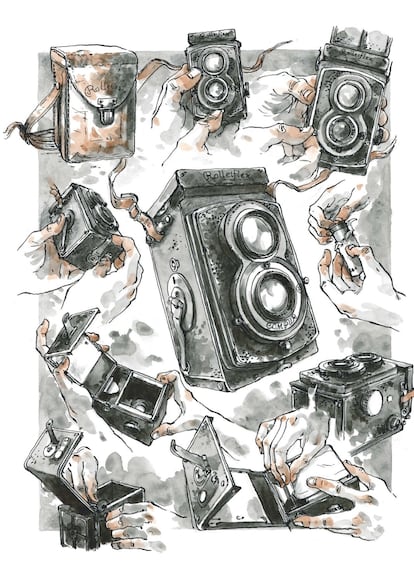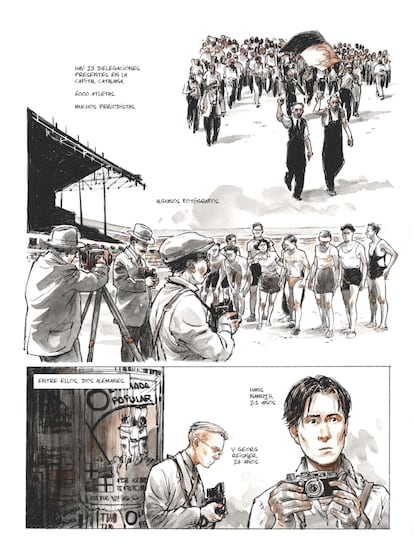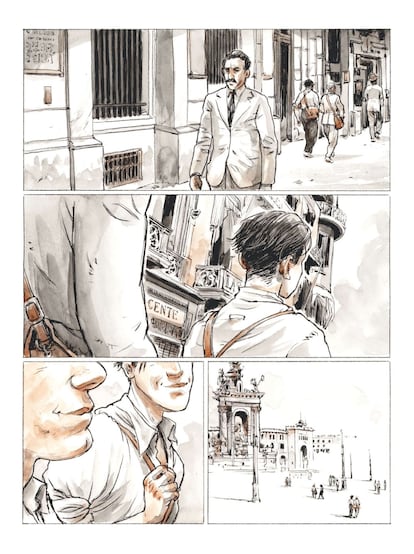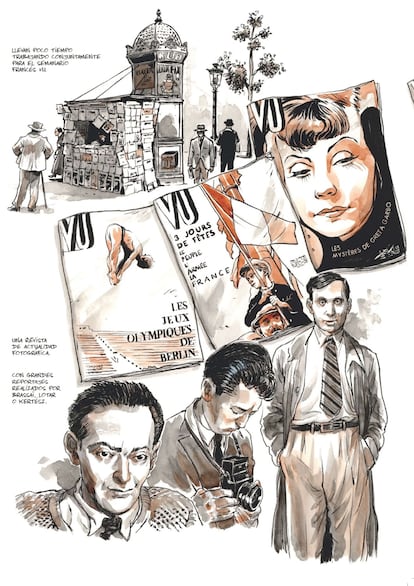Two young German photographers, Hans Namuth, 21, and Georg Reisner, 24, arrived in Barcelona in July 1936 to take images of the popular Olympiad, an event that was going to be inaugurated on the 19th of that month, with 6,000 athletes, and that wanted to be the alternative to the Berlin games, scheduled for August – historic, especially for the four gold medals Black American, Jesse Owens, with Hitler of spectator in the box. However, Namuth and Reisner, two anti -fascists who had fled precisely from Nazi Germany, did not know that two wars were going to cross into their lives. Its story is told, in a moving tone, in the graphic novel War photographers (Comic Planet), work of the duo formed by the scriptwriter Raynal Pellicer and the cartoonist Titwane.
Pellicer, French father and Valencian grandparents, explains on the phone that he and Titwane have long done “enlightened reports, some of more than 200 pages”, but who had been thinking of making a comic. The idea of undertaking arose when Pellicer saw “in The world A photograph of the siege to the Alcazar de Toledo during the civil war signed by Namuth and Reisner. “Who would be? It caught her attention because it is not usual for war photos to have two authors and because the images of the Spanish conflict are associated, above all, names like Robert Capa or Agustí Centelles.” It was a work of archaeologist to know their lives. “
The result of the work of Pellicer and Titwane was reflected in a comic published in France in 2023, now translated into Spanish – it is expected edition in Germany – with a drawing of extraordinary quality and a plot based on real events. “We have had several sources,” explains Pellicer. “First, Namuth had written a newspaper, which is at the International Center of Photography (ICP), in New York; then I looked for his relatives, like Namuth’s daughter and a granddaughter of Reisner’s brother, who told me things. There were also the photographs they published then in Vu”French leftist weekly, Broken design.
The screenwriter had found out that both friends constantly exchanged their cameras, a Leica and a Rolleiflex, to the point that days after taking images they did not know which of the two had made them. Pellicer wrote a first version of the script and the time of sharing with the cartoonist came. “Usually, I do not give him technical indications, he is working on the assembly of the comic.”

In War photographers It is striking that the pages that narrate the contradictions suffered by the German duo, which launched to the streets of Barcelona to photograph the fighting between insurgents and militias, are dominated by a pastel brown. “This story begins in July, very hot, and we wanted to use a warm tone.” Later, when the situation is complicated for both, the authors pass to black and gray. “The comic has its language and colors indicate what happens.”
Namuth and Reisner had arrived in Barcelona from Puerto de Pollensa (Mallorca), where they had opened their study in the summer of 1935. The two had had bitter experiences with fascism. Namuth had been arrested in July 1933 for distributing anti -zis pamphlets. He was imprisoned in Essen and released because his father was affiliated with the Nazi party, but preferred to leave his country. Reisner had the triple stigma of socialist, Jewish and homosexual. So in 1933 he left Breslau (today Polish City).

“Then, they met in Paris. Georg’s brother worked there in a German refugee association who had fled the Nazis. Georg, who was already a photographer, proposed to Hans, who was not, to work together. They settled in Mallorca to sell photos to tourists. In addition, there were many Germans,” Pellicer details.
When they moved to Barcelona to portray the popular Olympiad, which was going to be a week of sport and folklore, they found hours before the inauguration with the military insurrection of July 18. “They became for nine months in war photographers by chance.” Pellicer regrets that much of his work was lost, destroyed by the Gestapo when Germany invaded France. “Only 40 images were left in the ICP, saved by Namuth, and a few years ago the National Arxiu of Catalonia found another 100”.

After publishing their fighting work in Barcelona, the two travel the line of the front: Madrid, Talavera de la Reina, Toledo or Cerro Muriano, in Córdoba, where Capa took in those days the celebrated photo of the dead militiaman. Artillery fire, airplanes that machine the people fleeing horrified from their homes with the post, campaign hospitals … The horror of the war remains in its retinas and in their cameras. As Antoine de Saint-Exupéry said about the Spanish conflict: “Here you shoot how trees are talked.”
On his return to the capital they find that, due to their sympathies for the Marxist Unification Workers Party (POUM), which opposed Stalin, the Soviet representatives in Madrid urge them to stop taking photos and to put feet in dusty.
Back to France, they look again at another war, the World Cup. His status as Germans makes them suspect, so they are sent to concentration camps of the French government, in conditions of precariousness and overcrowding. When France falls against Hitler, they are in a desperate situation of which they will be very uneven lucky. Namuth gets ready in the foreign legion. While his friend does not see the light at the end of the tunnel: “The Nazis and Mussolini, on the one hand; Franco, on the other and Pétain (the head of the collaborative France) in the middle,” he says.

After those terrible years, Namuth, already in the United States, did not want to return to war photography. He specialized in artist portraits: Mark Rothko, Kooning Willem and, above all, he was known to Jackson Pollock; or architects, such as Walter Gropius, Ludwig Mies van der Rohe and Frank Lloyd Wright. He was director of films photography and traveled to Guatemala several times – where his wife was – to portray the indigenous people. After all the atrocities he saw, he died in a traffic accident in 1990, at 75. Reisner, exhausted from fleeing aimlessly, had decided, in December 1940, to leave the world dog that had to live.

